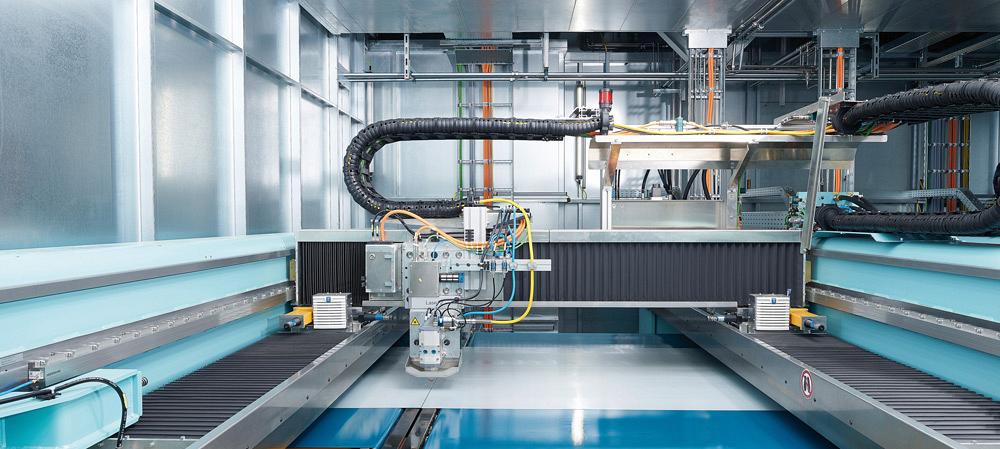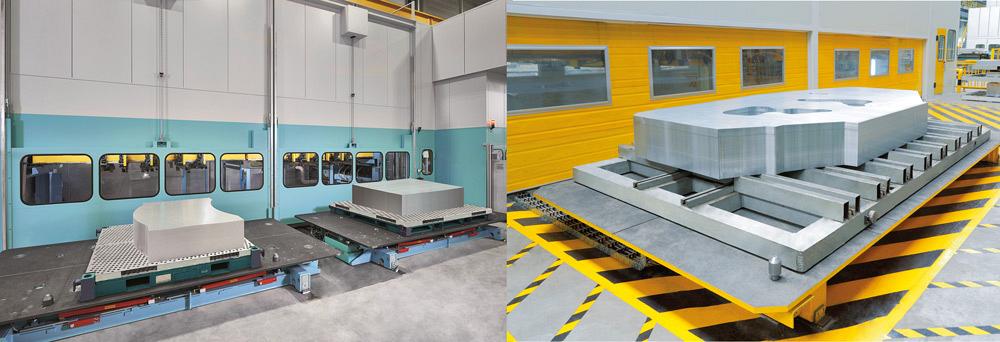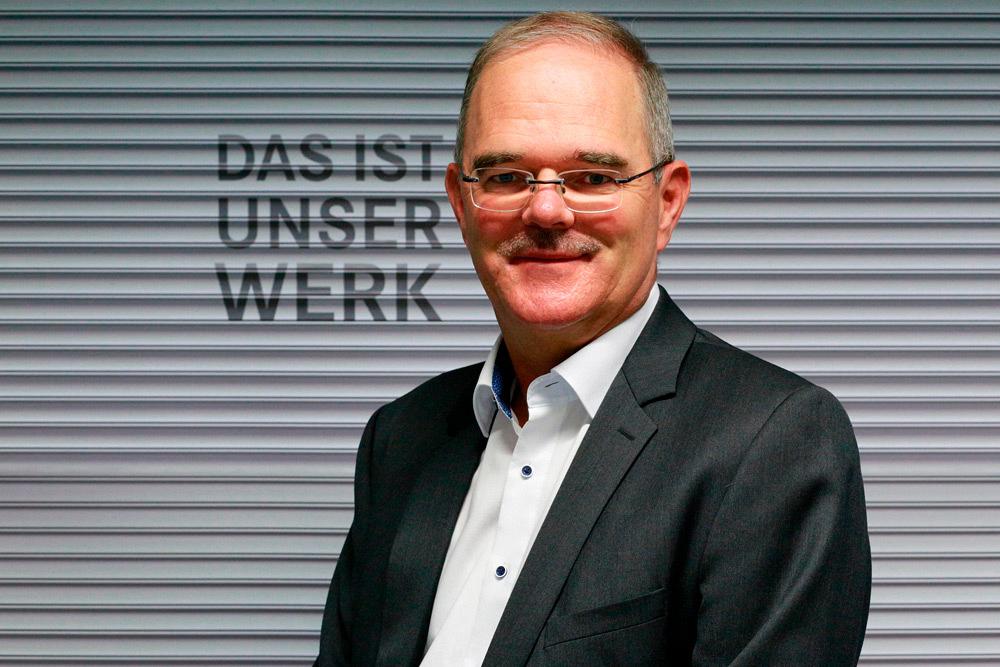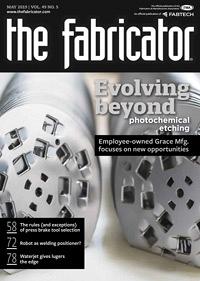Senior Editor
- FMA
- The Fabricator
- FABTECH
- Canadian Metalworking
Categories
- Additive Manufacturing
- Aluminum Welding
- Arc Welding
- Assembly and Joining
- Automation and Robotics
- Bending and Forming
- Consumables
- Cutting and Weld Prep
- Electric Vehicles
- En Español
- Finishing
- Hydroforming
- Laser Cutting
- Laser Welding
- Machining
- Manufacturing Software
- Materials Handling
- Metals/Materials
- Oxyfuel Cutting
- Plasma Cutting
- Power Tools
- Punching and Other Holemaking
- Roll Forming
- Safety
- Sawing
- Shearing
- Shop Management
- Testing and Measuring
- Tube and Pipe Fabrication
- Tube and Pipe Production
- Waterjet Cutting
Industry Directory
Webcasts
Podcasts
FAB 40
Advertise
Subscribe
Account Login
Search
Laser blanking reaches the automotive OEM
The story of laser blanking’s success at Daimler
- By Tim Heston
- May 4, 2019
- Article
- Laser Cutting

Two wide telescopic conveyors move in tandem underneath the active laser cutting heads, maintaining a consistent gap underneath for fumes and molten material to evacuate.
One day in early 1974, the then editors of The FABRICATOR perused a manuscript about a bleeding-edge technology that had spent years in the lab but was just then starting to make an appearance on the fabrication shop floor. Next to a grainy photo of a 500-watt CO2 laser mounted onto an oxyfuel cutting machine, the article stated: “Now, after all these years of promise, lasers have become an acceptable metalworking tool.”
This turned out to be an understatement. All these years later, the laser dominates precision sheet metal fabrication. It has blossomed in part because of its ability to cut any shape in any orientation. Nest layouts on a flat-bed laser in a high-product-mix, low-volume job shop resemble works of art.
Of course, as order volumes grow, laser cutting traditionally has made less economic sense. This remained the case even as the fiber laser took the market by storm more than a decade ago. A fantastically fast fiber laser looks incredibly productive, but the cutting head still needs to trace the part’s profile.
A stamping press can cut a blank’s profile all at once, hence the stamping press’s dominance in high-volume blanking, particularly in the automotive industry. There’s no way a laser could outpace a traditional blanking line with mechanical stamping presses—right?
Not necessarily. Laser blanking lines have made their way to some early adopters around the world, including SET Enterprises, a Michigan-based metal service center. In 2016 Daimler installed two laser blanking lines at the Mercedes-Benz plant in Kuppenheim, Germany. One more laser blanking line started production at another Mercedes-Benz plant in Germany at the beginning of this year, and a fourth line is in assembly stage.
The latest laser blanking lines exhibit the “toolless” flexibility that most metal fabricators with flat-bed cutting lasers have enjoyed for years. But some laser blanking lines also match, and sometimes exceed, the speed of many press-based blanking lines installed around the world. It’s a feat that The FABRICATOR editors in 1974 probably couldn’t have imagined.
Some History
The term laser blanking isn’t new, but it can spur confusion, especially for those outside the automotive supply chain. It’s in no way related to “tailor-welded blanks,” sometimes called “laser-welded blanks,” in which different cut profiles are joined by laser welding to create a single blank that has properties tailored to the application.
The concept behind laser blanking in the U.S. goes back to the 1990s. Around the turn of the millennium, a multicompany consortium called Laser Blanking Central asked a question that, in retrospect, was ahead of its time: What if a blanking press could be replaced by a coil-fed laser cutting system?
The group, which included companies like DCT in Sterling Heights, Mich., and Alabama Laser Systems in Munford, Ala., along with laser experts such as Charles Caristan (now a technical fellow at Air Liquide), developed some initial concepts. A coil would be fed into a precision leveler, then into a laser cutting bed, after which robots or other devices would offload the cut parts and (when necessary) dispose of the skeleton. Since then advancing technology, including the high-brightness fiber laser, has made that concept a reality.
Why Laser Blanking?
Today’s auto industry has more model variation than ever, which of course has made die changes a target for improvement. Single-minute exchange of dies (SMED) is a great idea, but not having a die to change in the first place is even better.
A blanking die is most cost-effective when it produces blanks with straight lines and angles. A laser prefers to work with a contoured blank, where the cutting head never has to decelerate entirely, turn, and accelerate around a sharp corner—and it just so happens that many of those contoured shapes aid formability in a stamping press, particularly for the drawing process. Regardless of the blank shape, laser blanking allows engineers to tweak it for better forming.
Cars and trucks of the future also will need to be lighter and safer, hence the demand for advanced high-strength steels and other materials with seemingly ever-growing strength-to-thickness ratios. These materials aren’t kind to blanking dies. The laser, on the other hand, doesn’t care about a material’s tensile strength, just the thickness and the material grade’s ability to absorb the laser’s energy. Laser blanking doesn’t eliminate all concerns about high-strength materials—the coil-fed material still needs to be leveled before it reaches the laser cutting heads—but removing the blanking die does mitigate a fair number of technical hurdles.
A Highly Choreographed Dance
Andreas Heuer, head of forming technology at Mercedes-Benz for the Gaggenau and Kuppenheim plants, began looking at the process at first for purely pragmatic reasons: The company didn’t want to alter its existing plant to make room for huge machine foundations, looping pits, and a high bay for the overhead cranes required to change blanking dies.
“We have no need for additional space for die storage, and we don’t need overhead cranes for die changes anymore,” he said. “The high flexibility that comes along with this technology is also very beneficial for us, because we have an increasing number of vehicle types.
“[Laser blanking] also has simplified geometric changes during the introduction of new die sets [for forming],” Heuer continued, adding that some blank geometry changes have aided downstream drawing processes. “For some sets, we created six to eight different [blank] geometries. This has allowed us to implement changes quickly without disrupting current production.”
Daimler now is using laser blanking to produce several cosmetically critical outer body components. “The plant is achieving a line speed in some applications up to 60 meters per minute,” said Germany-based Manuel Hunger, director of sales at Schuler, which designed and built Daimler’s laser blanking lines. “For instance, the line has produced more than 40 hoods per minute.”
“We cut blanks for all outer body parts and bigger structural parts for the main body for Mercedes-Benz cars and trucks,” Heuer continued. “We use the typical grades used by other car manufacturers, like galvanized steel and aluminum, ranging from 0.65 to 1.5 mm thick.”
Looking at the plant’s laser blanking line in action is like watching a highly choreographed dance, with each electronic and mechanical component playing a critical part. A coil is loaded onto a dual-coil payoff system as the previous coil is in process. If the new material requires it, the precision roller-leveler cassettes swap out automatically within a few minutes. When a coil change needs to happen, the uncoiler picks up and presents the new coil, which is fed with slack (no looping pit) through the leveler and into the laser cutting system.
The laser cutting work envelope has three laser cutting heads, each with a separate 4-kW IPG fiber laser power source. The heads move in the X direction as well as Y (across the strip).
Hunger said that having three laser cutting heads strikes a good balance. Having fewer heads slows the blanking speed, while having more heads leads to an excessive number of piercings, accelerations, and decelerations, simply because each laser head would be cutting only a small portion of the nest passing under it. And as part of a continuously fed sheet, the nest is truly “passing under” the laser.

Cut parts are stacked, transported out of the system and staged, ready to be transported downstream.
The core technology of laser blanking lies not with the laser cutting itself, but instead what happens underneath the kerf. The strip needs to keep moving, have space underneath for evacuating molten material, and remain fully supported—all at the same time.
To make this happen, laser blanking systems make smart use of telescopic conveyors. In Daimler’s laser blanking systems, two wide conveyors—one ahead of the active laser head(s) and one behind, positioned with a consistent gap between them—move forward and backward in the X direction (with and against the material flow), synchronized with the cutting action. This ensures the system always maintains a consistent gap underneath the cutting action, where gravity and a vacuum pull molten material, particulate, and fume away from the cut itself. Schuler calls this synchronized conveyor and fume extraction system “DynamicFlow Technology.”
Denesting and Stacking
After cutting comes denesting and stacking, two critical elements without which laser blanking wouldn’t make much sense. Yes, some laser blanking systems have become so fast in certain applications that they’re outpacing some conventional blanking systems, but that fact wouldn’t mean much if the blanks had to be sorted manually.
As Hunger explained, laser blanking has several denesting scenarios, where good parts are separated from scrap. The first involves jobs that cut nests that leave no scrap whatsoever. Daimler’s laser-blanked hoods, common-line-cut one after the other, are a prime example. The hood blanks span the full width of the strip, emerge from the laser cell, pass through a cleaning process, then are sent down separate conveyors to high-performance stackers that are similar to those used on traditional blanking lines.
“We are doing this [at Daimler] because robot stacking isn’t fast enough for the application,” Hunger said.
Another denesting scenario involves a nest with scrap that falls away in a so-called “gravity shedding” operation, which occurs outside the laser work envelope. This method works only if the scrap is oriented and shaped in such a way that it falls easily away from the strip.
From here stacking can occur one of two ways. If the part orientation allows for it, and the gravity shedding is proven to be reliable, then cut parts can flow directly to the stackers, just as they would in a no-scrap situation, while the scrap falls into a scrap chute and into a bin. Alternatively, a series of robots can grasp the parts out of the skeleton and transport them over the scrap chute onto a conveyor belt leading into the stacker.
Cleanliness in Blanking
Daimler blanks cosmetically critical outer body parts, hence the need for a brush-based blank cleaning process after laser cutting. “Dirt and dust contamination were major concerns for us,” Heuer said, adding that even without the extra cleaning step, the process left “only minor dust that would be irrelevant for our following process steps.
“As of today we can say that the equipment, like traditional blanking lines, needs frequent cleaning to ensure blank cleanliness. We currently do a biweekly standard cleaning and a half-yearly intensive cleaning of all conveyors.”
“To reduce the manual cleaning of the line, each conveyor belt can be equipped with a brush cleaning unit,” Hunger added.

Andreas Heuer, head of forming technology at Mercedes-Benz for the Gaggenau and Kuppenheim plants, has managed the Kuppenheim plant’s transition to laser blanking, which began in 2017. Photo courtesy of Daimler AG.
The Future of Laser Blanking
According to Hunger, Daimler’s lines are reaching overall equipment effectiveness (OEEs) levels beyond 75 percent. “We’ve never been able to reach such a level in a conventional blanking line,” he said.
Being an early adopter, Heuer sees laser blanking eventually becoming the dominant blanking process in automotive. “In my opinion, laser blanking will substitute conventional blanking. The technology is a modern and innovative way to optimize the blanking process and increase efficiencies. And dies that are optimized for laser blank geometries will help make laser blanking more beneficial.”
What about other areas of metal fabrication? According to Hunger, the technology eventually could find a home in more service centers outside the automotive supply chain, and even at large sheet metal fabricators, particularly those that consume a large amount of certain material grades and thicknesses—enough to buy a coil at a time.
Coil and leveler-cassette changes offer quick changeover from one material to another. Daimler, for instance, uses an automated process in which an operator inspects the material and initiates the changeover.
The critical elements are denesting and stacking. As Hunger explained, certain automated denesting approaches on a laser blanker can follow some of the same strategies as automated denesting from a flat-bed laser. For instance, smaller parts can be tabbed together and lifted out by the robot as one unit.
Of course, part volumes need to be adequate. “The laser blanking system is not ideal for handling [many] different shapes at the same time,” Hunger said, adding that it also requires nontabbed parts to be at least 250 mm long or wide.
Sure, prototype and high-mix, low-volume fab shops won’t likely see a use for such laser blanking equipment in the foreseeable future. But if part volume grows, the story could change. If a fabricator’s or service center’s mix of cut profiles can be reliably denested, stacked, and sent quickly downstream, laser blanking then becomes a distinct possibility.
About the Author

Tim Heston
2135 Point Blvd
Elgin, IL 60123
815-381-1314
Tim Heston, The Fabricator's senior editor, has covered the metal fabrication industry since 1998, starting his career at the American Welding Society's Welding Journal. Since then he has covered the full range of metal fabrication processes, from stamping, bending, and cutting to grinding and polishing. He joined The Fabricator's staff in October 2007.
Related Companies
subscribe now

The Fabricator is North America's leading magazine for the metal forming and fabricating industry. The magazine delivers the news, technical articles, and case histories that enable fabricators to do their jobs more efficiently. The Fabricator has served the industry since 1970.
start your free subscription- Stay connected from anywhere

Easily access valuable industry resources now with full access to the digital edition of The Fabricator.

Easily access valuable industry resources now with full access to the digital edition of The Welder.

Easily access valuable industry resources now with full access to the digital edition of The Tube and Pipe Journal.
- Podcasting
- Podcast:
- The Fabricator Podcast
- Published:
- 04/16/2024
- Running Time:
- 63:29
In this episode of The Fabricator Podcast, Caleb Chamberlain, co-founder and CEO of OSH Cut, discusses his company’s...
- Industry Events
16th Annual Safety Conference
- April 30 - May 1, 2024
- Elgin,
Pipe and Tube Conference
- May 21 - 22, 2024
- Omaha, NE
World-Class Roll Forming Workshop
- June 5 - 6, 2024
- Louisville, KY
Advanced Laser Application Workshop
- June 25 - 27, 2024
- Novi, MI

































